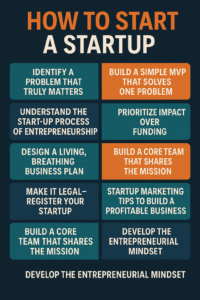How to Start a Startup: Build Not Just a Business, But a Legacy
“Every great business doesn’t start with a plan; it starts with a reason.”
How to start a startup isn’t just a question—it’s a personal journey. It begins with a moment of clarity and evolves into something far greater than money: a meaningful purpose.
Every founder, mentor, or entrepreneur once stood where you are—holding an idea, driven by passion, and fueled by a desire to build something exceptional. But the difference between success and struggle is clarity. This blog is your roadmap to not just launching a startup but crafting a legacy.
Step-by-Step Guide to Begin Your Legacy

🔍 Step 1: Identify a Problem That Truly Matters
Every lasting venture solves a real problem. It’s not about getting rich quick—it’s about creating solutions that improve people’s lives.
Ask yourself:
- What frustrates people daily?
- What issue do I feel compelled to solve?
- How can I improve what already exists?
The best startup ideas aren’t born from fantasy—they come from frustration, empathy, and a desire to make things better.
🧭 Step 2: Understand the Start-up Process of Entrepreneurship
The startup process isn’t an overnight success story. It’s a step-by-step build—refining your idea, building systems, and setting up a sustainable structure.
This phase includes:
- Crafting your business startup plan
- Clarifying your niche
- Understanding your customer’s pain points
Whether you’re exploring how to start a startup in India or anywhere else, this foundational phase is universal.
🧩 Step 3: Design a Living, Breathing Business Plan
Forget the 40-page static document. A modern startup business plan is dynamic and focused.
Ask:
- Who are your target customers?
- What’s your offer?
- How will you deliver it?
- How will you generate revenue?
Think in simple frameworks like a one-page Lean Canvas.
🧪 Step 4: Validate Before You Build
Don’t invest resources without validation. Real feedback matters more than assumptions.
Validation happens when:
- People say, “I need this.”
- They’re willing to pay
- Early users show up organically
Start conversations. Real products are built through real interactions.
🏛 Step 5: Make It Legal—Register Your Startup
The dream becomes real when it’s officially registered.
Depending on your goals, choose:
- Sole Proprietorship
- LLP
- Private Limited Company
Legal registration builds trust, helps with funding, and unlocks tax advantages.
🤝 Step 6: Build a Core Team That Shares the Mission
You don’t need a big team—you need the right team.
Early-stage teams should:
- Complement your skills
- Believe in your mission
- Focus on vision over resumes
Build a tribe, not a task force.
🛠 Step 7: Build a Simple MVP That Solves One Problem
A Minimum Viable Product (MVP) is not about features—it’s about solving one painful problem with simplicity.
Use tools like
- Canva (branding)
- Notion (project planning)
- Webflow (website)
- ChatGPT (copywriting, automation)
💸 Step 8: Prioritize Impact Over Funding
Don’t start by chasing investors—start by building trust. Begin by bootstrapping. Once you’ve validated demand, explore funding.
You can then approach:
- Incubators
- Startup grants
- Angel investors
But remember: momentum matters more than money in the beginning.
📢 Step 9: Startup Marketing Tips to Build a Profitable Business
Don’t just promote a product—share your purpose.
Use marketing as a storytelling tool:
- Share your journey and founder story
- Create helpful, educational content
- Run free webinars and workshops
- Use emotional storytelling to connect
Offer value before asking for attention—that’s the path to profitability.
🧠 Step 10: Develop the Entrepreneurial Mindset
A startup journey is more mental than mechanical. You’ll face rejection, doubt, and delay—but your mindset determines your direction.
To thrive:
- Be patient
- Stay curious
- Practice self-discipline
- Reconnect with your “why” often
🚀 Final Words: Don’t Just Start a Company—Start a Legacy
So, the real question isn’t how to start a startup. It’s why you want to start one.
When you build with clarity, serve with purpose, and lead with people—you don’t just launch a business. You spark a movement.
Stop waiting for the right moment—create it.
Start now. Build slow. Grow bold. Your legacy is waiting.
🔗 Let’s Stay Connected
If this blog helped you take your first step towards building a legacy-driven startup, let’s continue the conversation.
👉 Visit my LinkedIn profile to connect, learn, and grow together: Anurag Dangi
👉 Want to go deeper? Read my previous blog: “How to Use AI in Coaching Business.”
Your journey matters. Let’s build something extraordinary—together. 💼🚀

